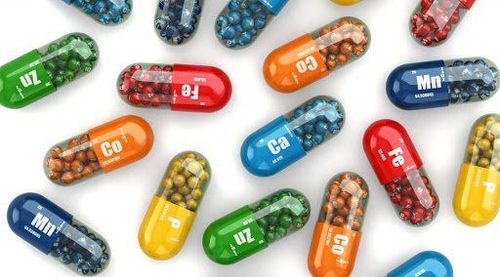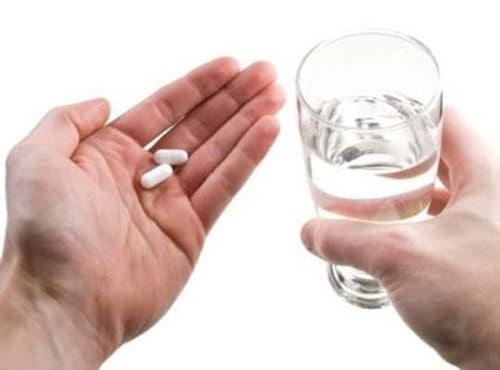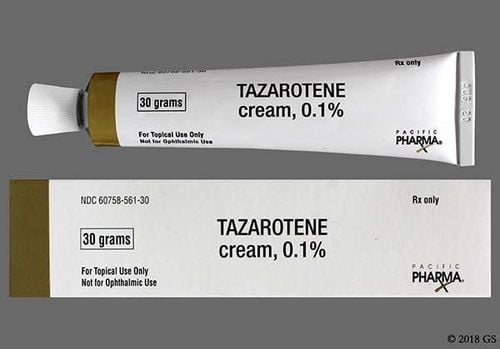This is an automatically translated article.
Fat-soluble vitamins include the four vitamins A, D, E and K, which are found in foods containing fats and these vitamins are insoluble in water. The body absorbs these vitamins like dietary fats, and these vitamins help the body function properly.The body absorbs fat-soluble vitamins best when eaten with foods high in fat. The following article provides helpful information on the types, functions and sources of fat-soluble vitamins, and what can happen if a person has too much or too little.
1. Fat-soluble vitamins
Vitamins are nutrients needed by the body in small amounts to help maintain life and enhance resistance. Most vitamins cannot be made by the body, so they need to be provided in the diet.Vitamins are grouped into fat-soluble vitamins and water-soluble vitamins. Fat-soluble vitamins include: Vitamin A, Vitamin D, Vitamin E, Vitamin K.
2. Vitamin A
Vitamin A plays an important role in maintaining your eyesight. Without Vitamin A, you will have impaired vision.
2.1 Types of Vitamin A Vitamin A is not a single compound. Rather, it is a group of fat-soluble compounds known collectively as retinoids.
The most common form of vitamin A in the diet is retinol. Other forms - retinal acid and retinol - are found in the body, but are absent or rare in foods. Vitamin A2 (3,4-dehydroretinol) is an alternative, less active form found in freshwater fish.
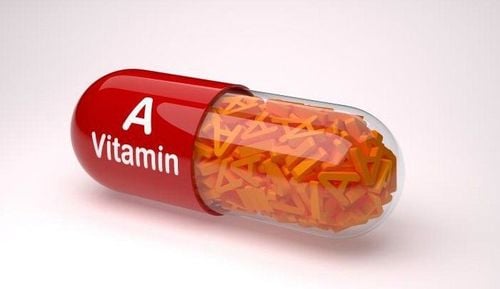
Vitamin A không phải là một hợp chất đơn lẻ
2.2 Roles and Functions Vitamin A supports many important aspects of bodily function, including:
Maintaining vision : Vitamin A is needed to maintain light-sensing cells in the eye and to form tears Immune function : Vitamin A deficiency impairs immune function, increases susceptibility to infections Body growth : Vitamin A is required for cell growth. A deficiency can slow or prevent growth in children Hair growth: It is also important for hair growth. Deficiency leads to hair loss or hair loss Reproductive function : Vitamin A maintains fertility and is important for fetal development 2.3 Nutritional sources Liver, whole milk, cheese, butter and more Reduced-fat foods are good sources of dietary retinol. Carrots, dark green leafy vegetables, and orange fruits, such as mangoes and apricots, are good sources of dietary carotenoids.
Vitamin A can also be obtained from certain carotenoid antioxidants found in plants. These are collectively known as provitamin A.
The most effective of these is beta-carotene, which is found in many vegetables, such as carrots, kale, and spinach.
2.4 Recommended amount
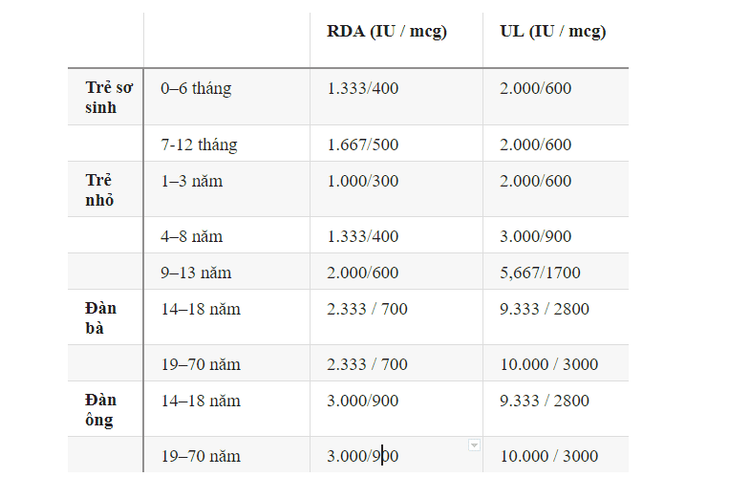
RDA is the estimated amount of vitamin A that the vast majority (about 97.5%) of people need to meet their daily needs. The UL is the highest daily intake considered safe for 97.5% of healthy people.
2.5 Deficiency Although provitamin A is abundant in many fruits and vegetables, it is not always efficiently converted to retinol, the active form of vitamin A. The effectiveness of this conversion depends depends on individual genetics.
Vitamin A deficiency is a serious public health problem worldwide. Deficiencies are also common in some developing countries. It is common in people whose vegetarian diets are mainly refined rice, white potatoes or cassava and lack meat, fat, and vegetables.
A common symptom of early deficiency includes night blindness. As it progresses, it can lead to more serious conditions, such as:
Dry eyes: Severe deficiency can cause inflammatory eye disease, a condition characterized by dry eyes due to decreased formation of the eye. tear. Blindness: Severe vitamin A deficiency can lead to total blindness. In fact, it is one of the most common causes of blindness in the world Hair loss: If you are deficient in vitamin A, you can start to lose hair Skin problems: Deficiency leads to the condition skin called hyperkeratosis Poor immune function: Poor condition or deficiency of vitamin A makes the body vulnerable to infections 2.6 Toxicity Overdose of vitamin A leads to an adverse condition known as vitamin A fortification. Rare but can have serious health effects.
Its main cause is an overdose of vitamin A from supplements, liver or cod liver oil.
The main symptoms and consequences of poisoning include fatigue, headache, irritability, stomach pain, joint pain, loss of appetite, vomiting, blurred vision, skin problems, and inflammation of the mouth and eyes .
It can also lead to liver damage, bone loss and hair loss. In extremely high doses, vitamin A can be fatal.
People should avoid exceeding the prescribed limit for intake, which is 10,000 IU (900 mcg) per day for adults.
Higher amounts, or 300,000 IU (900 mg), can cause acute hypervitaminosis A in adults. Children can be adversely affected in much lower amounts.
Pregnant women should also be especially careful, as high doses of vitamin A can harm an unborn baby. Doses as low as 25,000 IU per day have been linked to birth defects.
2.7 Benefits of Supplements Most people get enough vitamin A from their diets and do not need to take a supplement. However, controlled studies show that vitamin A supplements may be beneficial for some people even if their diets meet baseline requirements.
For example, vitamin A supplements can help treat measles in children.
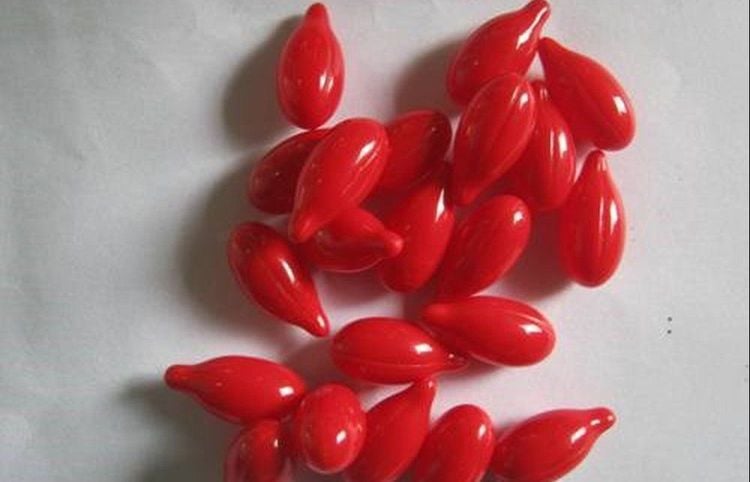
Dùng quá liều vitamin A dẫn đến một tình trạng bất lợi được gọi là tăng cường vitamin A
3. EASY Vitamins
Commonly known as the sunshine vitamin, vitamin D is synthesized when your skin is exposed to sunlight. Vitamin D is best known for its beneficial effects on bone health, and a deficiency makes you very susceptible to fractures.
3.1 Types of Vitamin D Vitamin D is a general term used to describe several related fat-soluble compounds.
Vitamin D exists as vitamin D2 (ergocalciferol) or vitamin D3 (cholecalciferol). Vitamin D2, widely distributed in plants and fungi, is derived from the UV irradiation of plant sterols ergosterol. Vitamin D3 is formed from UV irradiation on 7-dehydrocholesterol in the skin of animals including humans when exposed to direct sunlight.
According to some other views, vitamin D is not a vitamin but a pro-hormone, which acts as a precursor to one of the hormones involved in calcium homeostasis. Vitamin D is first converted to 25 hydroxyvitamin D (25OHD) and then to the active hormone 1,25-dihydroxyvitamin D (1,25(OH) 2D) in the liver and kidneys. In this form, it acts as a hormone that regulates the metabolism of calcium and phosphorus, which are necessary for bone mineralization. Calcium homeostasis is also important for neuromuscular function.
3.2 Roles and Functions Vitamin D has many roles and functions, but only a few have been well-studied including:
Bone maintenance: Vitamin D regulates circulating levels of calcium and phosphorus, which are The most important mineral for bone growth and maintenance. It promotes the absorption of these minerals from the diet. Regulates Immune System: It also regulates and enhances immune system function Once absorbed into the bloodstream, the liver and kidneys convert calciferol into calcitriol, which is the biologically active form of vitamin D. Vitamin D can also be stored for later use as calcidiol.
Vitamin D3 is converted to calcitriol more efficiently than vitamin D2.
3.3 Sources of Vitamin D Your body can produce all the vitamin D it needs on its own just make sure you regularly expose the majority of your skin to direct sunlight.
However, many hybrids spend little time in the sun or wear too thick clothes or who use sunscreen to prevent sunburn. While using sunscreen is highly recommended, it reduces the amount of vitamin D produced by your skin.
For the above reasons, people often use vitamin D supplements through their daily diet.
However, very few foods naturally contain vitamin D. The best food sources are fatty fish and oily fish, eggs, margarine, and mushrooms that have been UV-irradiated, which can also contain significant amounts. .
3.4 Recommended Amounts The table below shows the recommended dietary allowance (RDA) and upper limit (UI) for vitamin D.
As no RDA has been established for infants, the Values marked with “*” are adequate intakes (AI). AI is similar to RDA, but based on weaker evidence.
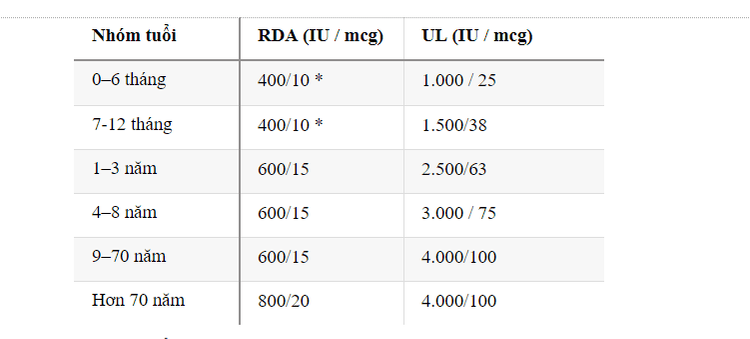
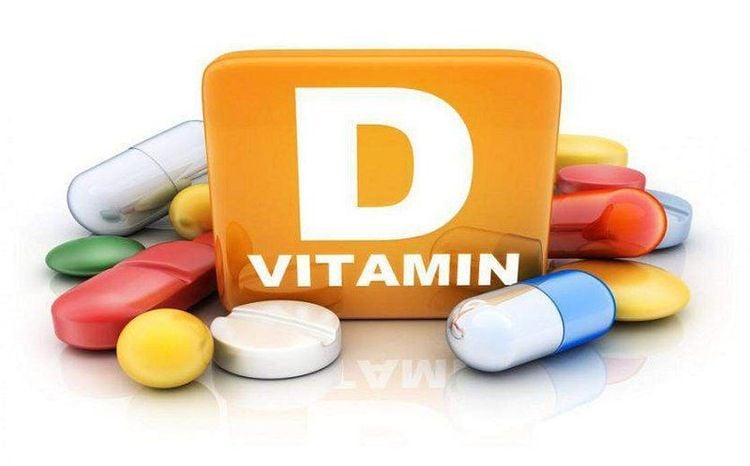
Vitamin D có nhiều vai trò và chức năng
3.5 Deficiency Severe vitamin D deficiency is rare, but mild forms of deficiency are common in people with long hospital stays, growing children, as well as the elderly.
Risk factors for deficiency are dark skin color, old age, obesity, less sun exposure, and diseases that impair fat absorption.
The best known consequences of vitamin D deficiency include soft bones, weak muscles and an increased risk of fractures. This condition is called osteomalacia in adults and rickets in children.
In adults, vitamin D is needed to maintain healthy bones. A deficiency can lead to osteomalacia, which often presents with bone and muscle aches, and proximal muscle weakness, making it difficult to stand and walk leading to a marked waddling gait. Vitamin D deficiency is not a direct cause of osteoporosis, but vitamin D can be helpful in managing the disease. There is little evidence of an association between vitamin D deficiency and other non-musculoskeletal health outcomes, including cardiovascular disease, hypertension, autoimmune diseases (eg, multiple sclerosis). and type 1 diabetes), neuropsychiatric function and cancer.
Vitamin D deficiency is also associated with poor immune function, increased susceptibility to infections and autoimmune diseases.
Other signs of deficiency or decline may include fatigue, depression, hair loss, and difficulty in wound healing.
Observational studies also show low levels or deficiencies of vitamin D with a higher risk of cancer death and a higher risk of heart attack.
3.6 Toxicity The skin's synthesis of vitamin D is self-regulating and so prolonged sun exposure does not lead to overproduction of vitamin D. Diets high in vitamin D can have toxic effects and have harmful effects. can lead to hypercalcemia (high levels of calcium in the blood).
Hypercalcemia can lead to excess calcium deposition in soft tissues and bone demineralization, and damage to the heart and kidneys. The European Food Safety Authority (EFSA) (2012) has established the Tolerable Upper Intake of vitamin D as 100 μg/day which is equivalent to 4000 IU daily for adults.
Higher amounts, ranging from 40,000–100,000 IU (1,000–2,500 mcg) per day, can cause symptoms of toxicity in adults when taken daily for a month or two.
3.7 Benefits of Vitamin D Supplements For those who get little sun exposure and rarely eat fatty fish or liver, supplements can be a good source of Vitamin D. Regularly taking supplements seems to prolong the life of people, especially the elderly who are hospitalized.
Adequate vitamin D supplementation may reduce the risk of respiratory infections.
4. Vitamin E
Considered a powerful antioxidant, as vitamin E acts as an antioxidant and is needed to protect cells against oxidative damage from free radicals, such as lipid oxidation in membrane.
4.1 Compounds Vitamin E is a group of eight lipid-soluble compounds synthesized by plants, including:
Tocopherol: Alpha-tocopherol, beta-tocopherol, gamma-tocopherol and delta-tocopherol. Tocotrienol: Alpha-tocotrienol, beta-tocotrienol, gamma-tocotrienol and delta-tocotrienol. In which, Alpha-tocopherol accounts for 90% of vitamin E in human tissues.
4.2 The Role and Function of Vitamin E Vitamin E's primary role is to act as an antioxidant, preventing oxidative stress and protecting the fatty acids in your cell membranes from free radicals.
These antioxidant properties are enhanced by other nutrients, such as vitamin C, vitamin B3 and selenium.
In high amounts, vitamin E also acts as a blood thinner, reducing blood clotting.
4.3 Nutritional Sources Foods that contain large amounts of polyunsaturated fatty acids will usually contain large amounts of vitamin E, so the richest sources of vitamin E are vegetable oils, nuts, and seeds. Since vegetable oils are the richest source, deficiencies are rare.
Other rich sources include butter, peanut butter, margarine, fatty fish and cod liver oil.
4.4 Recommended Amounts The table below shows the RDA and tolerable upper limit for vitamin E intake. Values marked with an asterisk are adequate amounts, as there is no RDA value for children. new-born.
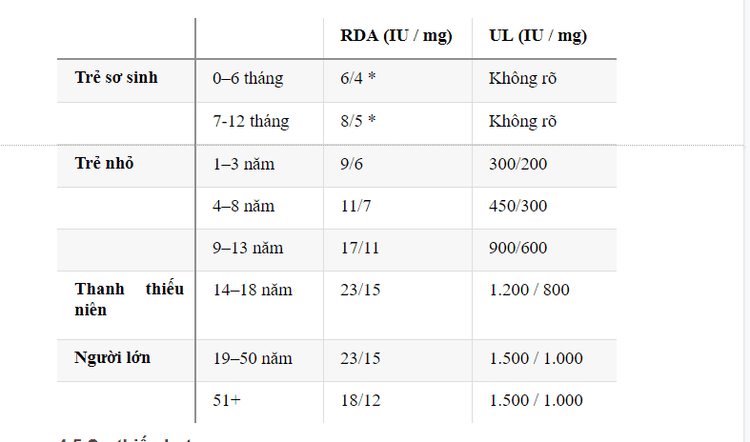
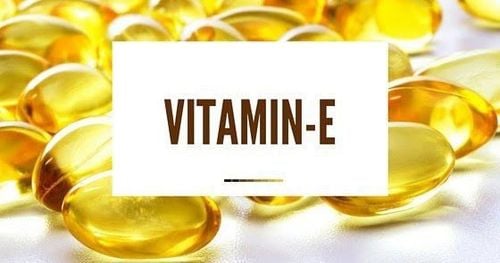
Vai trò chính của Vitamin E là hoạt động như một chất chống oxy hóa
4.5 Deficiency A deficiency in dietary vitamin E is not considered a problem even in people with a relatively poor diet. A deficiency occurs only in people with severe fat malabsorption such as cystic fibrosis, liver disease, and rare genetic disorders.
Symptoms of vitamin E deficiency include muscle weakness, difficulty walking, tremors, vision problems, poor immune function, and numbness.
A severe, long-term deficiency can lead to anemia, heart disease, serious neurological problems, blindness, dementia, poor reflexes, and an inability to fully control muscle movements body.
4.6 Toxicity Vitamin E has very low toxicity and humans seem to be able to tolerate high amounts of the vitamin without being severely affected (eg 540-970 mg/day). However, at very high doses vitamin E can have a negative effect on other fat-soluble vitamins; it exacerbates the effects of vitamin K deficiency causing excessive bleeding so people taking blood thinners should avoid taking large doses of vitamin E, which also interferes with vitamin A absorption.
4.7 Benefits and the risks of consuming or taking too much vitamin E A form of vitamin E, gamma-tocopherol, has been found to increase blood flow by promoting the dilation of blood vessels, potentially reducing blood pressure. pressure and risk of heart disease.
Gamma-tocopherol supplements may also have blood-thinning effects as well as lowering levels of "bad" LDL cholesterol.
In contrast, other studies show that high doses of vitamin E supplements can be harmful, even if they don't cause any obvious symptoms of toxicity.
For example, observational studies show that vitamin E supplementation is associated with an increased risk of prostate cancer and all-cause mortality.
5. Vitamin K
Vitamin K plays an important role in blood clotting. Without it, you risk bleeding to death.
5.1 Types of Vitamin K Vitamin K is essentially a group of fat-soluble compounds that are divided into two main groups:
Vitamin K1 (phylloquinone): Found in foods of plant origin, phylloquinone is the form main source of dietary vitamin K Vitamin K2 (menaquinone): This type of vitamin K is found in foods of animal origin and fermented soy products, such as natto. Vitamin K2 is also produced by intestinal bacteria in the colon. In addition, there are at least three synthetic forms of vitamin K. These are called vitamin K3 (menadione), vitamin K4 (menadione diacetate) and vitamin K5.
5.2 Roles and Functions Vitamin K is required for the synthesis of several proteins required for normal blood clotting and bone structure. Vitamin K is synthesized by bacteria in the large intestine and is also present in both animal and plant foods.
5.3 Nutritional Sources The best dietary sources of vitamin K1 (phylloquinone) are green leafy vegetables, while vitamin K2 (menaquinone) is mainly found in foods of animal origin and other foods. fermented soybean products.
In contrast to phylloquinone, menaquinone is only found in small amounts in certain high-fat, animal-based foods, such as egg yolks, avocados, and liver.
It is also found in some soy foods, such as natto.
5.4 The AI Recommended Amount is similar to the RDA, which is a daily intake that is said to meet the requirement of 97.5% of people, but the evidence-based AI is weaker than the RDA
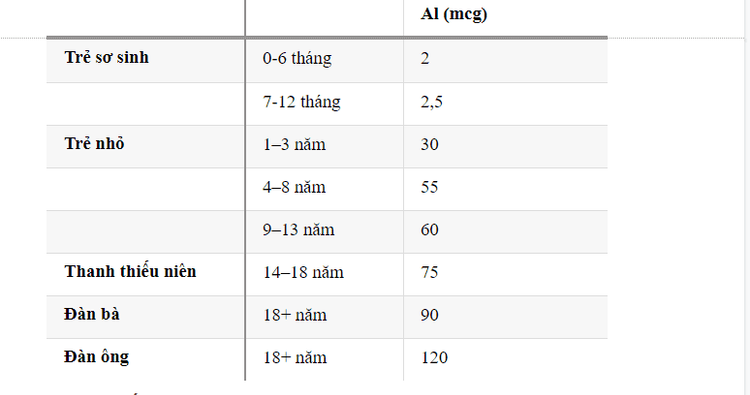
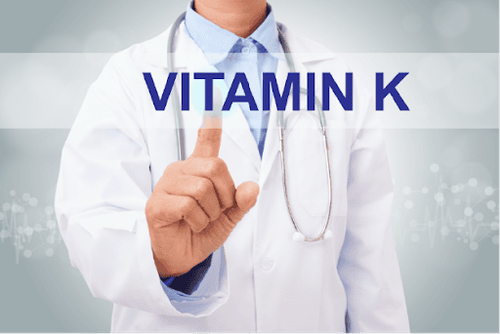
Lượng vitamin K thấp cũng có liên quan đến việc giảm mật độ xương và tăng nguy cơ gãy xương ở phụ nữ
5.5 Deficiency A deficiency is rare because vitamin K is available from the diet and is also provided by gut bacteria. Thus, deficiency is often secondary to conditions such as malabsorption or impaired intestinal synthesis including those with celiac disease, inflammatory bowel disease, and cystic fibrosis.
However, there is growing interest in vitamin K's role in optimizing bone health. Infants up to six weeks of age have low levels of vitamin K, putting them at risk for potentially fatal 'hemorrhagic disease of the newborn', known as vitamin K deficiency bleeding in infants . So, is it regular for babies to take prophylactic vitamin K?
Use of broad-spectrum antibiotics can also increase the risk of deficiency, as well as very high doses of vitamin A, which appear to reduce vitamin K absorption.
Large doses of vitamin E can also counteract the effects of the vitamin. K for blood clotting.
Without vitamin K, your blood won't clot and even a small wound can cause bleeding that won't stop. Fortunately, vitamin K deficiency is rare, as the body only needs small amounts to maintain blood clotting.
Low vitamin K intake is also associated with reduced bone density and increased fracture risk in women.
5.6 Toxicity Unlike other fat-soluble vitamins, natural forms of vitamin K do not show any toxicity symptoms.
There is only one synthetic form of vitamin K, called menadione or vitamin K3, which can have some side effects when consumed in large amounts
5.7 Benefits of supplementation Several controlled studies have To investigate the effects of vitamin K supplementation in humans. These studies suggest that vitamin K supplements — vitamin K1 and vitamin K2 — can reduce osteoporosis and reduce the risk of fractures.
In addition, vitamin K2 supplementation at a dose of 45–90 mg per day slightly increased the survival time of patients with liver cancer.
Observational studies also show that a high intake of vitamin K2 may reduce the risk of heart disease. However, evidence from controlled studies is limited and inconclusive
Finally, vitamin K1 supplementation at a dose of 0.5 mg daily for three years slowed the development of insulin resistance in men old. No significant differences were detected in women.
For children to be healthy and develop well, it is necessary to have a nutritious diet in terms of quantity and quality balance. If children are not provided with adequate and balanced nutrients, it will lead to diseases of excess or lack of nutrients, which adversely affect the comprehensive development of children in terms of physical, mental and motor skills.
Children who do not eat properly are at risk of micro-mineral deficiency causing anorexia, growth retardation, malabsorption,... If they notice the above signs, parents should supplement their children with products. The supplement contains lysine, essential micro-minerals and vitamins such as zinc, chromium, selenium, and B vitamins to help fully meet the nutritional needs of children. At the same time, these essential vitamins also support digestion, enhance nutrient absorption, help improve anorexia, and help children eat well.
Parents can learn more:
Signs of zinc deficiency in children
Micronutrient deficiency and failure to gain weight in children
Please regularly visit Vinmec.com website and update useful information to take care of your child. Take care of the baby and the whole family.
Article reference source: nutrition.org.uk, healthline.com






